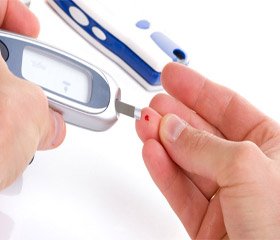Журнал «Медицина неотложных состояний» 8 (55) 2013
Вернуться к номеру
Integrated intensive care hepato-intestinal dysfunction and metabolic disorders in patients with diabetic ketoacidosis
Авторы: Brick R.P. - Kharkiv Medical Academy of Postgraduate Education, Kharkiv, Ukraine
Рубрики: Медицина неотложных состояний
Разделы: Клинические исследования
Версия для печати
Impaired function of liver and intestine plays an important role in the pathogenesis of DKA (diabetic ketoacidosis). Digestive disorders bowel function does enteral route of administration of nutrients ineffective. Causes of hepato-intestinal dysfunction - vegetative neuropathy, hypoxia, changes in intestinal flora, water and electrolyte imbalance, intoxication.
Diabetic ketoacidosis, intensive care, enteral oxygenation, hepato-intestinal dysfunction.
The purpose of the study. To estimate the effect of conventional therapy and in combination with enteric oxygenation on indicators of hepatic blood flow, intra-abdominal pressure, metabolism, toxicity and functional status of vitally important organs in patients with DKA.
Materials and methods. The study involved 85 patients with diabetic ketoacidosis aged 18 to 63 years. Patients of group 1 (n=42, mean age - 43,2 ± 2,1 years) performed traditional therapy - insulin therapy using low doses, correction of fluid and electrolyte, respiratory and hemodynamic support pharmacy metabolic correction, eliminating factors that provoke decompensation. Patients in group 2 (n=43, mean age - 39,7 ± 2,3 years) additionally performed enteral oxygenation. Efficacy of treatment was assessed using reohepatography, measuring intra-abdominal pressure, biochemical studies.
Results and discussion. In patients with DKA revealed significant liver dysfunction with worsening blood volume pulse, decreased indices of arterial and venous blood flow, reduced tonic-elastic resistance arteries. Development enteroplegia leads to a significant increase in intra-abdominal pressure with significant circulatory disorders in splanchnic area. Indicators of intra-abdominal pressure were 16,4 ± 1,2 and 15,7 ± 1,3 mm Hg in patients 1 and group 2, respectively. In conducting therapy on the second day indicator abdominal pressure in patients of group 1 was 12 , 6 ± 1,0 mm Hg on the third day - 8,0 ± 1,0 mm Hg on the fifth day - 2,5 ± 0,7 mm Hg. Patients in group 2 values of pressure in the abdomen were 7,9 ± 1,1 mm Hg on the second day, 2,5 ± 0,6 mm Hg on the third day and 0,8 ± 0,3 mm Hg on the fifth day of treatment. At all stages are set statically probable differences from the patients of group 1 (p < 0,05).
Restoration of intestinal motility promoted earlier transfer of patients in group 2 for receiving enteral meats. Against the backdrop of infusion therapy and decrease abdominal pressure in patients of both groups in the dynamics of recovery observed in liver blood flow according reohepatography. In both groups, the tendency to normalization of liver blood volume pulse RI (reography index) to 0,8 ± 0,04 and 0,94 ± 0,04 for the fifth day in patients 1 and group 2 respectively . Established trend towards normalization of DIA (diastolic index), which characterizes the outflow of blood from the arterial to venous who recovered patients in group 2 already on the third day of treatment. Improved filling of large and small arteries of liver blood by increasing their tonic-elastic resistance (Vmax). Positive changes in patients in group 2 were statistically significant compared with patients of group 1. When conducting intensive therapy, a significant improvement of metabolism, especially in patients in group 2. Increasing saturation of venous blood from the normalization of this index on the fifth day of treatment in patients of group 2 indicates the elimination of hypoxia with normalization of aerobic processes in cells. Parallel decreased and returned to normal tissue oxygen extraction, which is caused by the decrease in metabolic demand (that, severity of hypoxia), and hemodynamic recovery with significant improvement in tissue perfusion. A decrease in the concentration of lactate in venous blood after 4-5 day to 2,0 ± 0,1 mmol/l in patients of group 1; 1,5 ± 0,03 mmol/l in patients in group 2 (p <0, 05).
Conclusions. In the application of IT within the enteric oxygenation is almost complete elimination of hepato-intestinal disease in most patients already on the third day of treatment, enabling an earlier transition to oral meats . During treatment of DKA set to reduce the manifestations of cellular hypoxia with increased saturation of venous blood lactate concentration decreased more pronounced in the application of IT within the enteric oxygenation.

